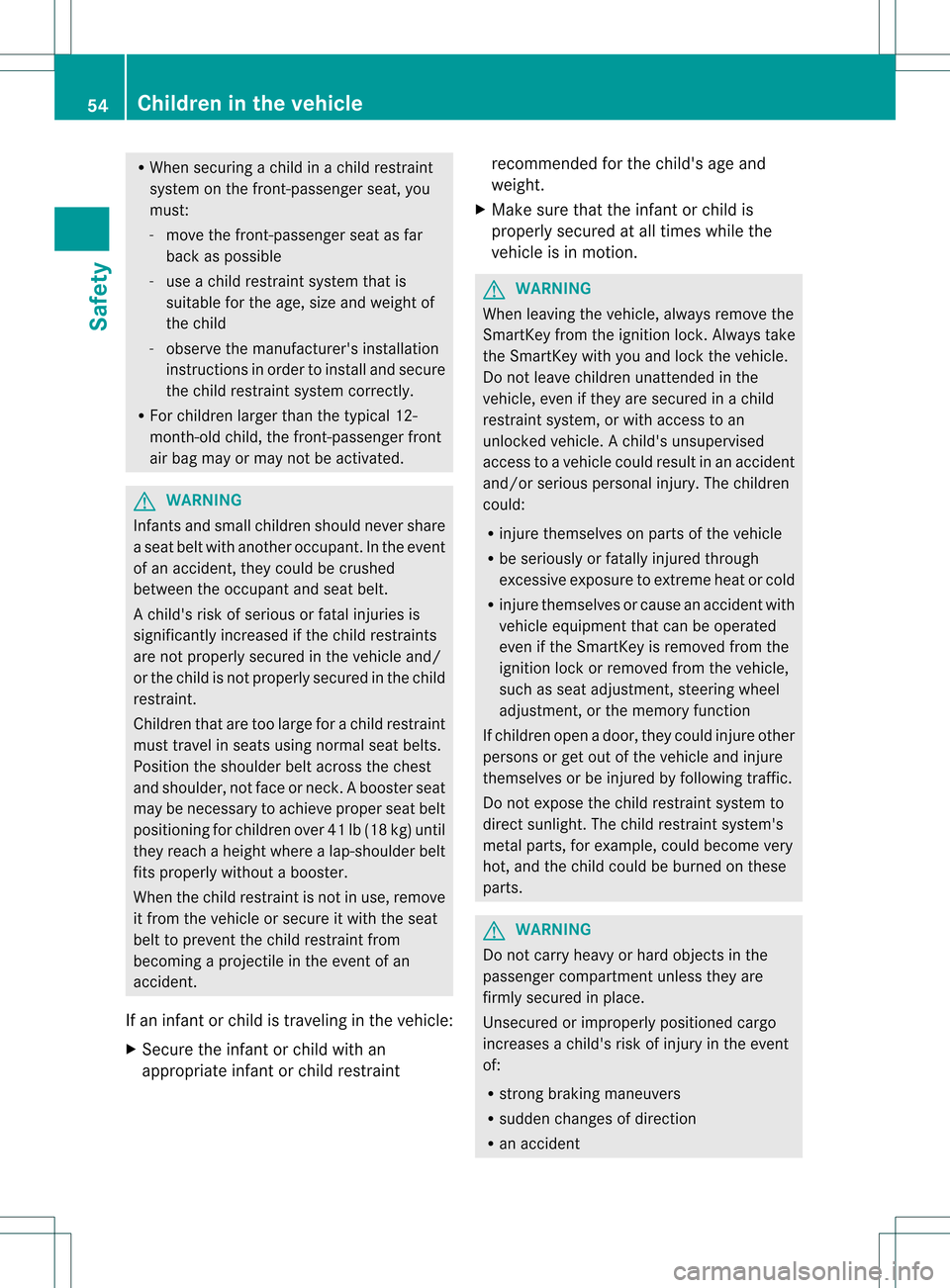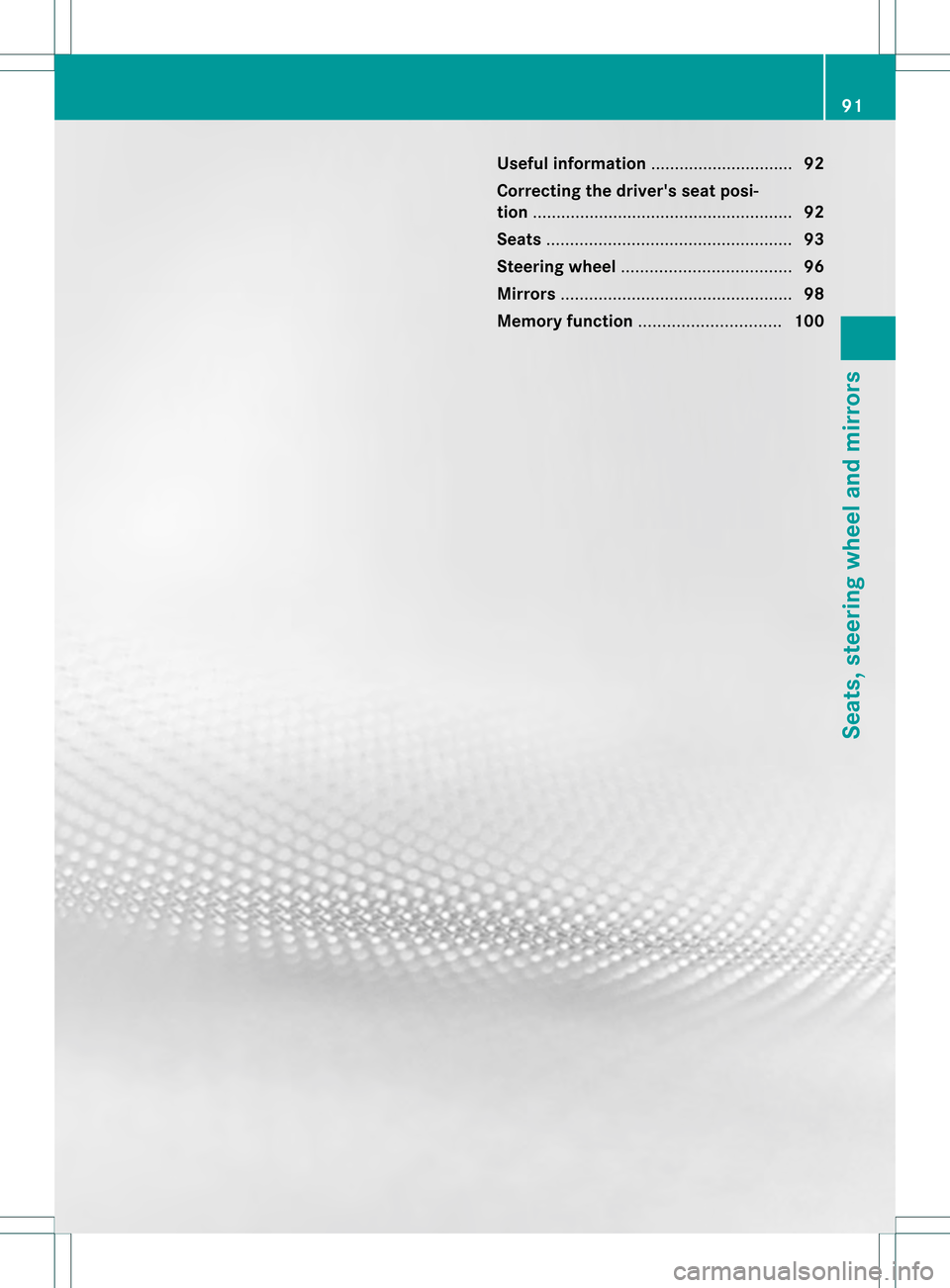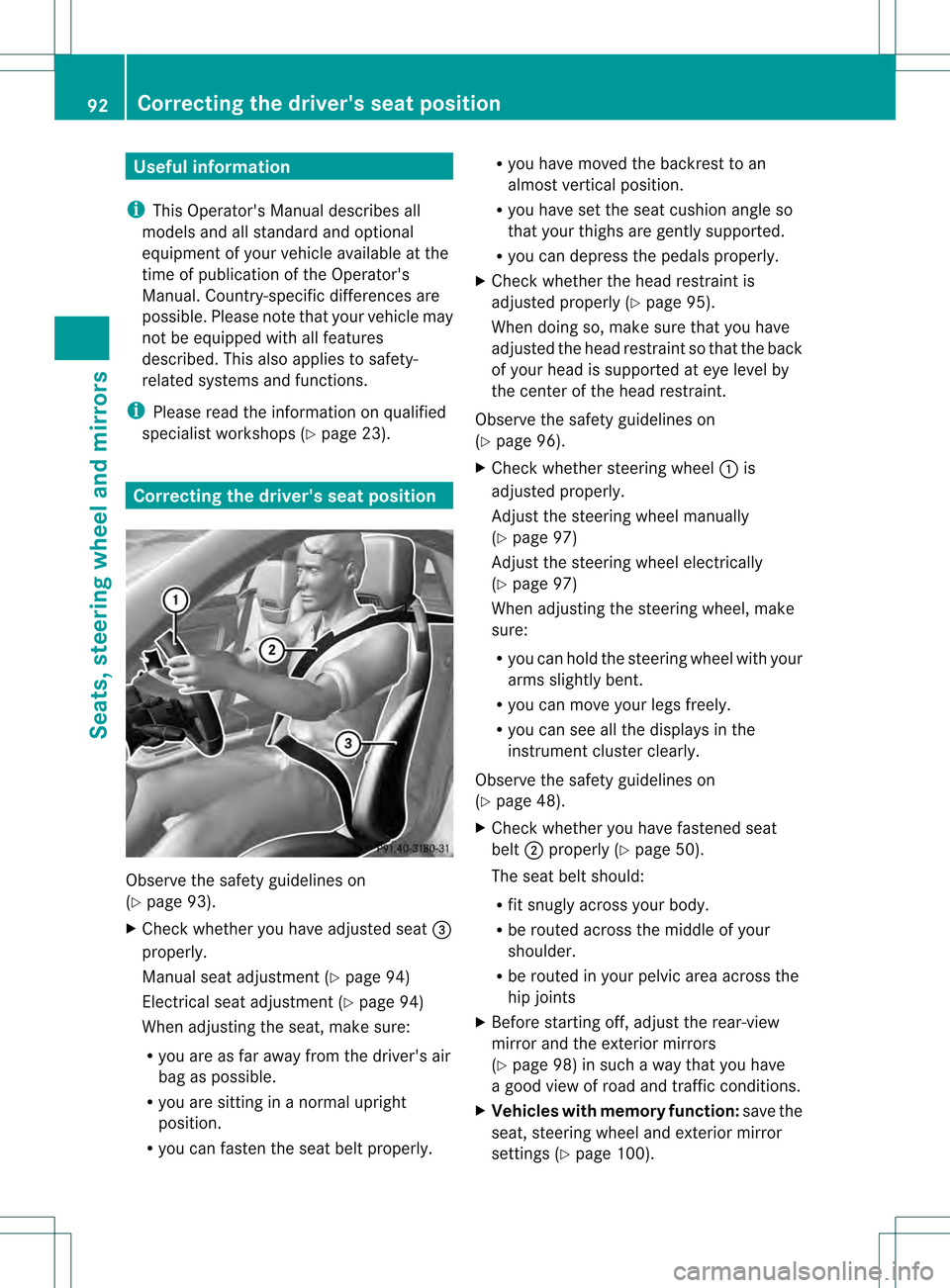2012 MERCEDES-BENZ SLK350 seats
[x] Cancel search: seatsPage 5 of 334

Index
....................................................... 4Introduction
......................................... 20 At
ag lance ........................................... 25 Safety
................................................... 35 Opening/closing
................................. 67 Seats, steering wheel and mirrors
....91 Lights and windshield wipers
..........103 Climate control
................................. 115 Driving and parking
..........................129 On-board computer and displays
....179 Stowage and features
......................241 Maintenance and care
......................259 Breakdown assistance
.....................273 Wheels and tires
............................... 293 Technical data
................................... 321 Contents
3
Page 9 of 334

Driving syste
m............................... 156
Function/notes ............................. 156
Important safety notes ..................156
Setting aspeed .............................. 157
Storing and maintaining current
speed ............................................ .157
Cup holder ......................................... 245
Customer Assistance Center (CAC) ...24
Customer Relations Department .......24 D
Dashboard see Cockpit
Data
see Technical data
Daytime running lamps
Display message ............................ 215
Switching on/off (on-board
computer) ...................................... 192
Switching on/off (switch) ..............105
Dealership
see Qualified specialist workshop
Delaye dswitch-off
Exterio rlighting (on-board
computer )...................................... 193
Interior lighting .............................. 193
Diagnostics connection ......................23
Digital speedometer .........................186
Display (cleaning instructions) ........269
Display messages Calling up (on-board computer) .....199
Driving systems ............................. 219
Engine ............................................ 216
General notes ................................ 199
Hiding (on-board computer) ...........199
KEYLESS-GO .................................. 226
Lights ............................................ .213
Safety systems .............................. 200
Service interva ldisplay .................. 264
SmartKey ....................................... 226
Tires ............................................... 222
Vehicle .......................................... .224
Distance display (on-board
computer) .......................................... 190
Distance recorder ............................. 185
see Odometer
see Trip odometer Distance warning (warning lamp)
....237
DISTRONIC PLUS Deactivating ................................... 166
Display message ............................ 220
Displays in the multifunction
displa y........................................... 165
Driving tips .................................... 166
Function/notes ............................. 158
Important safety notes ..................158
Setting the specified minimum
distance ......................................... 164
Warning lamp ................................. 237
Doors
Automatic locking (on-board
computer) ...................................... 193
Automatic locking (switch) .............. .75
Central locking/unlocking
(SmartKey) ...................................... .68
Control panel ................................... 33
Display message ............................ 224
Emergency locking ........................... 76
Emergency unlocking .......................76
Important safety notes ....................74
Opening (from inside) ......................75
Drinking and driving .........................152
Drinks holder see Cuph older
Drive program
Automatic ...................................... 143
Display ........................................... 140
Manual .......................................... .144
SETUP (on-board computer) ..........196
Driver's door
see Doors
Driver's seat
see Seats
Driving abroad
Mercedes-Benz Service .................265
Symmetrical low bea m.................. 104
Driving lamps
see Daytime running lamps
Driving on flooded roads ..................155
Driving safety systems ABS (Anti-lock Braking System) .......56
ADAPTIVE BRAKE ............................. 62
BAS (Brake Assist System) ..............57
BAS PLUS (Brake Assist System
PLUS) .............................................. .57 Index
7
Page 16 of 334

Refueling
Fuelgauge ....................................... 27
Important safety notes ..................146
Refueling proces s.......................... 147
see Fuel
Releasing the parking lock
manually (automatic
transmission) ..................................... 146
Remote control Garage door opene r....................... 254
Programming (garage door
opener) .......................................... 255
Reserve (fuel tank)
see Fuel
Reserve fuel
Display message ............................ 219
Warning lamp ................................. 234
see Fuel
Residual heat (climate control) ........125
Restraint system see SRS (Supplemental Restraint
System)
Reverse gear
Engaging (automatic
transmission) ................................. 140
Engaging (manual transmission) ....139
Reversible floor panel (trunk) ..........244
Roadside Assistance (breakdown) ....21
Roof Display message ............................ 225
Important safety notes ....................82
Opening/closing (with roof
switch) ............................................. 84
Opening/closing (with SmartKey) ....84
Problem (malfunction) .....................86
Relocking ......................................... 85
Roof carrier ........................................ 245
Roof lining and carpets (cleaning
guidelines) ......................................... 271
Roof switch .......................................... 83
Route (navigation) see Route guidance (navigation)
Route guidance (navigation) ............186 S
Safety Childre ninthe vehicle ..................... 53
Child restraint systems ....................53
Occupant Classification System
(OCS) ............................................... 42
Overview of occupant safety
systems ........................................... 36
Safety systems
see Driving safety systems
Seat belts
Adjusting the driver's and front-
passenger sea tbelt ......................... 51
Belt force limiters ............................ 52
Cleaning ......................................... 270
Correct usage .................................. 49
Emergency Tensioning Devices ....... .52
Fastening ......................................... 50
Important safety guidelines .............48
Releasing ......................................... 51
Safety guidelines ............................. 37
Specia lseat belt retractor ...............55
Switching belt adjustment on/off
(on-board computer) ......................194
Warning lamp ................................. 228
Warning lamp (function) ................... 51
Seats
Adjusting (electrically). ....................94
Adjusting (manually )........................ 94
Adjusting the 4-way lumbar
support ............................................ 95
Adjusting the head restraint ............95
Cleaning the cover .........................270
Correct driver's seat position ........... 92
Important safety notes ....................93
Seat heating problem ......................96
Storing settings (memory
function) ........................................ 100
Switching AIRSCARF on/off ............96
Switching sea theating on/off .........95
Sensors (cleaning instructions) .......269
Service Center see Qualified specialist workshop
Service interval display
Displaying service messages .........264
Hiding service messages ...............264 14
Index
Page 49 of 334

PRE-SAFE
®
(preventative occupant
protection)
i AMG vehicles do not include the PRE-
SAFE ®
system. G
WARNING
The PRE-SAFE ®
system reduces the impact of
an accident on vehicle occupants, as long as
their seat belts have been fastened correctly.
Although your vehicle is equipped with a PRE-
SAFE ®
system, the possibility of injury in the
event of an accident cannot be ruled out. You
should therefore always drive carefully and
adapt your driving style to the prevailing road,
weather and traffic conditions.
PRE-SAFE ®
takes preemptive measures to
protect occupants in certain hazardous
situations.
PRE-SAFE ®
intervenes:
R if BAS intervenes, e.g. in emergency
braking situations
R if BAS PLUS intervenes powerfully on
vehicles with DISTRONIC PLUS
R if, on vehicles with DISTRONIC PLUS, the
radar sensor system detectsani mminent
dange rofcollision in certain situations
R in critical driving situations, e.g. when
physical limits are exceeded and the
vehicle understeers or oversteers severely
PRE-SAFE ®
takes the following measures
depending on the hazardous situation
detected:
R the seat belts are pre-tensioned.
R on vehicles with memory function for the
front-passenger seat: the front-passenger
seat is adjusted if it is in an unfavorable
position.
R if the vehicle skids, the side windows are
closed so that only a small gap remains.
If the hazardous situation passes without
resulting in an accident, PRE-SAFE ®
slackens
the belt pretensioning. All settings made by
PRE-SAFE ®
can then be reversed. If the seat belts are not released:
X
Move the backrest or seat back slightly, but
only when the vehicle is stationary.
The belt pretensioning is reduced and the
locking mechanism is released. G
WARNING
Make sure that nobody can become trapped
as you adjust the seat.
! Make sure that there are no objects in the
footwell or behind the seats when resetting
the seats. There is a risk that the seats
and/or the objects could be damaged.
More information about seat-belt
adjustment, a convenience function
integrated into PRE-SAFE ®
, can be found in
the "Seat-belt adjustment" section
(Y page 51). NECK-PRO head restraints
The NECK-PRO head restraints increase
protection to the driver's and front
passenger's head and neck.T o this end, the
NECK-PRO head restraints on the driver's and
front-passenger seats are moved forwards
and upwards in the event of a rear-end
collision of a certain severity. This provides
better head support. G
WARNING
Do not secure any objects (e.g. coat hangers)
on the NECK-PRO head restraints. Otherwise,
the NECK-PRO head restraints may not
function properly, or in the event of a rear-end
collision may not be able offer the level of
protection they are designed to provide. G
WARNING
Seat or head restraint covers can cause a
malfunction when the NECK-PRO head
restraints are activated or when the side
impact air bags are deployed, or they can
prevent this completely. The NECK-PRO head
restraints or side impact air bags can Occupant safety
47Safety
Z
Page 52 of 334

the middle of the shoulde
r(it should not
touch the neck).
R Position the lap belt as low as possible on
your hips and not across the abdomen .If
the lap belt is positioned across your
abdomen, it could cause serious injuries in
a crash.
R Never wear seat belts ove rrigid or
breakable objects in or on your clothing,
such as eyeglasses, pens, keys etc., as
these might cause injuries.
R Make sure the seat belt is always fitted
snugly. Take special care of this when
wearing loose clothing.
R Never use a seat belt for more than one
person at a time. Do not fasten a seat belt
around a perso nand another perso nor
other objects at the same time.
R Seat belts should not be worn twisted. In a
crash, you would not have the full width of
the seat belt to distribute impact forces.
The twisted seat belt against your body
could cause injuries.
R Pregnant women should also always use a
lap-shoulder belt. The lap belt portion
should be positioned as low as possible on
the hips to avoid any possible pressure on
the abdomen.
R Place the seat backrest in a position that is
as upright as possible.
R Check your seat belt during travel to make
sure it is properly positioned.
R Never place your feet on the instrument
panel, dashboard, or on the seat. Always
keep both feet on the floor in front of the
seat.
R When using a seat belt to secure infant
restraints, toddler restraints, or children in
booster seats, always follow the child seat
manufacturer's instructions. G
WARNING
Do not pass seat belts over sharp edges. They
could tear. Do not allow the seat belt to get caught in the
door or in the seat adjustment mechanism.
This could damage the seat belt.
Never attempt to make modifications to seat
belts. This could impair the effectiveness of
the seat belts.
Fastening seat belts G
WARNING
Children 12 years old and under must be
seated and properly secured in an
appropriately sized infant restraint, child
restraint system, or booster seat
recommended for the size and weight of the
child. For additional information, see the
"Children in the vehicle" section.
Ac hild's risk of serious or fatal injuries is
significantly increased if the child restraints
are not properly secured in the vehicle and/
or the child is not properly secured in the child
restraint. X
Adjust the seat and move the backrest to
an almost vertical position (Y page 92).
X Pull the seat belt smoothly through belt
loop 0002.
X Without twisting it, guide the shoulder
section of the seat belt across the middle 50
Occupant safetySafety
Page 56 of 334

R
When securing a child in achild restraint
system on the front-passenger seat, you
must:
- move the front-passenger seat as far
back as possible
- use a child restraint system that is
suitable for the age, size and weight of
the child
- observe the manufacturer's installation
instructions in order to install and secure
the child restraint system correctly.
R For children larger than the typical 12-
month-old child, the front-passenger front
air bag may or may not be activated. G
WARNING
Infants and small children should never share
a seat belt with another occupant. In the event
of an accident, they could be crushed
between the occupant and seat belt.
Ac hild's risk of serious or fatal injuries is
significantly increased if the child restraints
are not properly secured in the vehicle and/
or the child is not properly secured in the child
restraint.
Children that are too large for a child restraint
must travel in seats using normal seat belts.
Position the shoulder belt across the chest
and shoulder, not face or neck.Ab ooster seat
may be necessary to achieve proper seat belt
positioning for children over 41 lb (18 kg) until
they reach a height where a lap-shoulder belt
fits properly without a booster.
When the child restraint is not in use, remove
it from the vehicle or secure it with the seat
belt to prevent the child restraint from
becoming a projectile in the event of an
accident.
If an infant or child is traveling in the vehicle:
X Secure the infant or child with an
appropriate infant or child restraint recommended for the child's age and
weight.
X Make sure that the infant or child is
properly secured at all times while the
vehicle is in motion. G
WARNING
When leaving the vehicle, always remove the
SmartKey from the ignition lock. Always take
the SmartKey with you and lock the vehicle.
Do not leave children unattended in the
vehicle, even if they are secured in a child
restraint system, or with access to an
unlocked vehicle. Achild's unsupervised
access to a vehicle could result in an accident
and/or serious personal injury. The children
could:
R injure themselves on parts of the vehicle
R be seriously or fatally injured through
excessive exposure to extreme heat or cold
R injure themselves or cause an accident with
vehicle equipment that can be operated
even if the SmartKey is removed from the
ignition lock or removed from the vehicle,
such as seat adjustment, steering wheel
adjustment, or the memory function
If children open a door, they could injure other
persons or get out of the vehicle and injure
themselves or be injured by following traffic.
Do not expose the child restraint system to
direct sunlight. The child restraint system's
metal parts, for example, could become very
hot, and the child could be burned on these
parts. G
WARNING
Do not carry heavy or hard objects in the
passenger compartmentu nless they are
firmly secured in place.
Unsecured or improperly positioned cargo
increases a child's risk of injury in the event
of:
R strong braking maneuvers
R sudden changes of direction
R an accident 54
Children in the vehicleSafety
Page 93 of 334

Useful information
..............................92
Correcting the driver's seat posi-
tion ....................................................... 92
Seats .................................................... 93
Steering wheel .................................... 96
Mirrors ................................................. 98
Memory function .............................. 100 91Seats, steering wheel and mirrors
Page 94 of 334

Useful information
i This Operator's Manual describes all
models and all standard and optional
equipment of your vehicle available at the
time of publication of the Operator's
Manual. Country-specific differences are
possible. Please note that your vehicle may
not be equipped with all features
described. This also applies to safety-
related systems and functions.
i Please read the information on qualified
specialist workshops (Y page 23).Correcting the driver's seat position
Observe the safety guidelines on
(Y
page 93).
X Check whether you have adjusted seat 0023
properly.
Manual seat adjustment (Y page 94)
Electrical seat adjustment (Y page 94)
When adjusting the seat, make sure:
R you are as far away from the driver's air
bag as possible.
R you are sitting in a normal upright
position.
R you can fasten the seat belt properly. R
you have moved the backrest to an
almost vertical position.
R you have set the seat cushion angle so
that your thighs are gently supported.
R you can depress the pedals properly.
X Check whether the head restraint is
adjusted properly (Y page 95).
When doing so, make sure that you have
adjusted the head restraint so that the back
of your head is supported at eye level by
the center of the head restraint.
Observe the safety guidelines on
(Y page 96).
X Check whether steering wheel 0002is
adjusted properly.
Adjust the steering wheel manually
(Y page 97)
Adjust the steering wheel electrically
(Y page 97)
When adjusting the steering wheel, make
sure:
R you can hold the steering wheel with your
arms slightly bent.
R you can move your legs freely.
R you can see all the displays in the
instrumen tcluste rclearly.
Observe the safety guidelines on
(Y page 48).
X Check whether you have fastened seat
belt 0003properly (Y page 50).
The seat belt should:
R fit snugly across your body.
R be routed across the middle of your
shoulder.
R be routed in your pelvic area across the
hip joints
X Before starting off, adjust the rear-view
mirror and the exterior mirrors
(Y page 98) in such a way that you have
a good view of road and traffic conditions.
X Vehicles with memory function: save the
seat, steering wheel and exterior mirror
settings (Y page 100). 92
Correcting the driver's seat positionSeats, steering wheel and mirrors